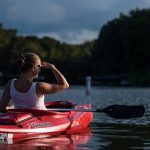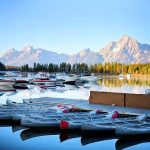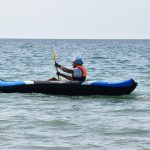Kayaking does not have a set beginning or ending time.
The degree of weather fluctuation you might experience when kayaking is determined by the location.
Most kayakers decide when to begin the season depending on their level of knowledge and personal preferences, taking into account the weather conditions they deem suitable.
The optimal time to begin kayaking is determined by how much time people are able to have their kayak out of storage.
In climates with cold weather, the onset of spring often makes people eager to go out kayaking.
Even for those who don’t mind the chill, kayaking in areas where bodies of water turn to ice may not be an option.
If you are in a location prone to snow and ice far into spring, then you can usually locate news online concerning the present conditions where you wish to go kayaking.
What Is the Best Season for Kayaking?
Most people believe the optimal period for kayaking is between late spring and early summer.
At this stage of the year, it is usually mild enough that you do not have to put on extra layers, yet not so harsh that you must take measures to stay cool.
The warm weather of Spring and Summer makes it an ideal time to take out kayaks that have been stored away, as there are perfect conditions for both camping and hiking related activities.
Kayaking during the spring and summer seasons exhibits the chance of being stuck outside in the rain.
One can stay away from dangerous weather by monitoring the forecast and recognizing the warning signs of unfavorable weather.
How Late In the Season Can I Still Go Kayaking?
As the warm days of summer start to become cooler autumn days, it may become more difficult to enjoy kayaking due to the dropping temperatures.
You should usually consider wearing a few additional articles of clothing so that you may take in the beauty of the foliage as it changes in color while on the lake.
In the majority of locations, it is best to plan to wrap up your kayaking season somewhere between September and December.
The degree to which this applies will depend on the climate of the place you intend to visit.
Once the snow falls or the temperatures fall to a point where the water can turn solid, you could risk harm by going out on the water.
Experienced kayakers may still opt to kayak during the winter, however, this needs a higher level of proficiency and organizing than someone who simply wants to canoe on the lake in the spring.
Kayakers participating in winter activities must make sure they are ready for the freezing temperatures in the water and the air.
It is advisable to wear a dry suit and extra waterproof garments to stay warm in case you overturn.
It is absolutely necessary to have a knowledgeable partner or multiple people when you go kayaking in cold weather.
Think about the path you will take to get to the destination where you will be kayaking.
If the roads might be coated with frost or snow, you must use a vehicle suitable for those conditions.
In many exterior areas, a 4WD car is the most suitable option for taking your kayak and equipment to a wintery stream or lake.
How Early In the Season Can I Go Kayaking?
Kayakers residing in the south have the advantage of being able to begin their season earlier than those who live in colder environments.
It is possible that regions may allow people to safely go kayaking as early as February.
Be on the lookout for signs of the season that signify what the weather will be like for your upcoming trip.
witnessing plants flourish is an indication that the advent of spring and hotter temperatures is near.
If you live in a chilly climate, you can observe indications that the snow is beginning to melt.
Whitewater kayaking can be made more thrilling when there is snow-related runoff raising the depth and intensity of the rivers.
If you love kayaking in an adrenaline-filled environment, you should watch for the beginning of the snow melt to determine when you should organize your trip.
Those wanting to go kayaking on a journey can consult prior years to help them determine when they can begin their paddling.
This source can also be used to make forecasts about what the weather will be like in the coming year.
It is important to remember that weather forecasts may not always be precise, however, examining past trends can give you a higher likelihood of what could occur.
Can You Kayak Year-Round?
It is feasible to go kayaking all year in certain places, but be sure to wear extra layers in case of any water splashes.
Kayaking may not be possible at some places during specific periods of the year.
The amount of rain that falls during different times of the year can have an effect on the amount of water in some places.
It is possible that you may find yourself in a river that does not have enough water to support your kayak if you choose the wrong time of the year to visit.
One might not be comfortable with navigating rivers and lakes that are frozen over, or have the expertise to tackle the rapids that occur during snowmelt as a novice kayaker.
If you are thinking of kayaking at an unusual time of year, it would be good to do some research to find out what to expect.
You can then compare this to your goals.
If you’re looking to spot orcas, you should be prepared for cold temperatures and go for a kayaking trip during the time of their migration.
What Factors Determine The Start Of Kayaking Season?
Many canoeists agree that the unofficial beginning of the canoeing season is in February and runs through March to the start of April.
That’s not the case for everyone, of course:
Many kayakers, especially experienced ones and fishermen, tend not to follow a specific time plan when it comes to beginning the season and choose to begin dependent on their own preference.
Besides, it also depends on where you live:
In colder climates, it might take more time for the temperature to rise. In some regions, the ice does not start melting until May; Siberia is an excellent illustration of this.
With that said, here are some factors that may dictate the start of the season:
Air Temperature
If you don’t mind the cold, you can go out when the temperature reaches 50 degrees. It is preferable for recreational kayakers to have an air temperature of 70 degrees Fahrenheit.
The heat of the air should counterbalance the coldness of the water. It’s prudent to delay until the ambient temperature increases in the springtime, which is typically sometime between the beginning of April and the end of May.
Water Temperature
It is not enough to consider the air temperature; the water temperature must also be factored in. Make no mistake about it:
Exposure to cold water can be deadly.
If you soak in water that is 60 degrees Fahrenheit or lower, you may suffer from a cold shock response which can be deadly. It is ideal that you don’t go out until the temperature of the water reaches 70 degrees.
Why?
Apart from the nice weather, you do not need to bring any extra items such as wet suits, dry suits, and emergency supplies.
Alternatively, just use the 120-degree rule:
If the total of the air and water temperatures is over 120 degrees, kayaking would be an excellent option due to the lack of potential for cold shock or hypothermia.
Flow Rate
The rate of movement is not essential for rivers and lakes that have a slow current, however, it is absolutely essential for whitewater kayaking. It would be pointless to attempt to navigate a river if the water is as tranquil as a domesticated feline.
The ideal time for whitewater kayaking begins at the start of spring when the flow rates start to increase due to the warmer weather. It is important for experienced whitewater kayakers to know that the stream velocity can occasionally be so intense that it exceeds their ability to manage, hence making it essential to understand how it might alter the difficulty of the river.
You can get up-to-date flow rate data here.
Daylight Hours
People often choose to go kayaking or canoeing during the summertime because they can enjoy the daylight. As the season progresses from winter to summer, the daylight hours expand, permitting for more time to enjoy activities on the water.
I suggest taking your kayak out of storage in the middle of spring unless you are highly devoted to the sport.
When Does Kayaking Season End?
If you’ve stuck with my ramblings, you might already know the answer to this one:
There’s no official end to the kayaking season.
Most people using a kayak for recreation usually end their season close to the start of fall, usually between September and October. At that point, the temperature of the water usually gets too chilly to be pleasant, the climate turns out to be not very reliable, and the hours of daylight start to dwindle.
You are still able to go kayaking during winter months and cold temperatures, although the winds may be quite chilly and the water close to freezing. Most people would rather wait till next year, though.
That reminds me:
It is necessary to maintain your kayak properly during the time it is not in use. Gather your necessary items, make sure any maintenance or fixes are taken care of, and locate a spot to keep your kayak.
What Time Of Year Is Best For Kayaking?
When is the prime time to take a kayaking trip depending on where one resides.
Generally speaking, the best time to go paddling is from early April to late September – and for obvious reasons:
The time when the environment and ocean vary evenly tends to provide ideal circumstances, or at least as favorable of a situation as is possible. The air and water are rather pleasing to the senses, and there is usually a good amount of sunshine.
Granted, the answer also depends on the type of activity you’re interested in:
If you would like to navigate down river rapids the optimum time is during the early to mid-spring months, when the snow and glaciers start to melt in the mountains, creating a higher flow in the rivers than usual, making the rapids more thrilling and enjoyable.
If you decide to go kayaking in the sea, it would be most ideal to do it during the summertime. The seas can be very unstable all year round, with the weather becoming even more dreadful in the winter season.
If uncertain, utilize the 120-degree rule to decide whether or not it is a good plan to go canoeing.
The Best Time To Go Kayaking By US States
I have made a chart displaying the periods of the year that are most liked by non-professional kayakers owing to the favorable weather circumstances, thusly avoiding the lengthy discussion about when is the ideal time to go kayaking for each distinct area.
Use it as a reference to figure out when ‘typically’ the kayaking season starts and ends in each US state:
| Year-Round | March to November | April/May to September | May to June |
|---|---|---|---|
| Alabama | Arkansas | Ohio | Alaska |
| Arizona | Kansas | Connecticut | |
| California | Kentucky | Delaware | |
| Florida | Missouri | Maine | |
| Georgia | Nebraska | Maryland | |
| Louisiana | Nevada | Massachusetts | |
| Mississippi | North Carolina | New Hampshire | |
| New Mexico | Oklahoma | New York | |
| Texas | Oregon | Pennsylvania | |
| Hawaii | South Carolina | Rhode Island | |
| South Dakota | Vermont | ||
| Tennessee | Virginia | ||
| Utah | West Virginia | ||
| Idaho | |||
| Colorado | |||
| Iowa | |||
| Michigan | |||
| Minnesota | |||
| Montana | |||
| Nebraska | |||
| New Jersey | |||
| North Dakota | |||
| Washington | |||
| Wisconsin | |||
| Wyoming |
In states like New Mexico, Texas, California, or Arizona in the southern United States, the climate tends to be hot and the kayaking season usually runs all year, only experiencing a brief interruption due to the strong storms during monsoon season.
In other locations, you may need to be especially vigilant during the cold season.
Conclusion: When Is Kayaking Season?
The beginning and conclusion of kayaking season is not defined by any specific rules. In certain months, kayaking and other on-the-water activities are more suited to doing than in other months.
The optimum time for kayaking generally ranges from the beginning of spring until the start of fall, though the weather, climate, and activities desired are also factors in deciding when it’s best to paddle.




